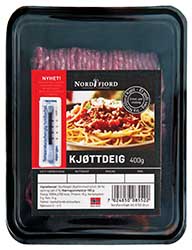Reports from the Front Lines of Packaging Innovation
PACKAGING
Once upon a time in the never-never land of protecting food products during their distribution cycle from farm or sea to table, came a storm of new food packaging called nanocomposites, liquid crystal oxygen barriers, radio frequency identifications, plasma discharge sterilization, active antimicrobial packaging, and multiple-layer structures. Reckoned as history by some who designate such sciences, they entered with great fanfare and streaked through our consciousnesses—the promise of the future—destined to disrupt every vestige of today and yesterday. Somehow, however, the foundations of our yesterdays—retort pouches and trays, aseptic packaging of particulates, microoxygen with or without hyper carbon dioxide, microwave pasteurization and sterilization, extended shelf life coupling processing and packaging hurdles, susceptors, and self-opening steamers—continue to dominate the so-called packaging innovation of today extrapolated into tomorrow.
Entering into the food packaging futures mix is a new organization, Active and Intelligent Packaging Industry Association (AIPIA) (www.aipia.info), headquartered in Utrecht, Netherlands, and headed by Eef de Ferrante. AIPIA’s recently concluded Congress in Nuremberg, Germany, included dozens of topics that should shake the conventional agendas of mainstream food packaging (e.g., printed electronics, ultra-thin chips, time-temperature integrators, optimization of modified atmosphere packaging, fresh labels, smart active labels, and more). Most exciting about the AIPIA Congress and its peripheries is that it appears to fill the void of the formerly vibrant IFT Food Packaging Division, identifying and probing the far frontiers of enhanced food packaging.
I have elected to devote most of this month’s column to highlighting some of what I regard as the more intriguing presentations from the AIPIA Congress and the coverage it generated in order to signal “hot topics in food packaging.”
Insights from AIPIA
Frederick Kern of PowerCoat Paper discussed “Preparing Packaging Materials for Printed Electronics and Sensors.” PowerCoat™ is a trade name for a non-plastic cellulosic formulation and coating process that offers an ultra-smooth, flexible optimum conductivity substrate for printed electronics. Ultra-high resolution circuit patterns can be printed directly on paper using significantly less ink and at lower temperatures, thus increasing thermal stability for control over sintering.
Speakers from Haydale and Gwent Electronic Materials presented on the topic “Graphene Nano Inks Ready to Use Commercially.” Graphene is an elemental form of carbon in a two-dimensional hexagonal matrix. The in-plane electrical conductivity is very high. Graphene inks are now being commercialized to enable their application to smart packaging, printed batteries, electrochemical sensors, flexible displays, and touch screens. Metal-free HDPlas™ graphene ink is formulated with optimum viscosity and solids content for screen printing to ensure uniform coverage and conductivity.
A presentation titled “Plant-Based Coating to Extend Shelf Life” included discussion of a patent issued to Esseoquattro SpA, Italy. Developed at University of Camerino in Italy, the process claims extended shelf life for meat and fish products. An antimicrobial coating is engineered to control generation of amines, thus extending shelf life of protein foods. The coatings are made from extracts of rosemary, oregano, and/or salvia, all of which contain terpenes, aldehydes, ketones, esters, carnosic acid, carnasol, eugenol, and thymol as active natural compounds. The coatings may be applied by spraying on polyester film substrates.
 Hakon Thaulow of Keep-it Technologies in Norway spoke on the topic “Time-Temperature Indicators Go Large!” According to Keep-it Technologies, the company has sold more than one million shelf-life indicators to major brand owners in retail and foodservice businesses in the Norwegian market. The units affixed to the primary packages detect temperature over time correlated to the biochemical degradation rates of the contained food product. Apparently the chemistry of these TTIs is different from those in many devices offered by others in the past.
Hakon Thaulow of Keep-it Technologies in Norway spoke on the topic “Time-Temperature Indicators Go Large!” According to Keep-it Technologies, the company has sold more than one million shelf-life indicators to major brand owners in retail and foodservice businesses in the Norwegian market. The units affixed to the primary packages detect temperature over time correlated to the biochemical degradation rates of the contained food product. Apparently the chemistry of these TTIs is different from those in many devices offered by others in the past.
“Reusable TTI Tag Enhanced by New Software” was the topic for Frits Van Calker of RFID Direct. This company has launched Log 2.0 for tracking and tracing perishable foods in distribution channels. Two main components are involved: RFID Direct’s Log 2.0 software plus CAEN RFID’s semi-passive ultrahigh frequency temperature-logging RFID tags. Data are forwarded to the software operating in the cloud for analysis and report generation. Tags are reusable for up to three years with a memory capable of storing up to 8,000 temperature points. Sensors can be programmed to read at preset intervals, to signal when a set point is exceeded, and to trigger alerts, thus eliminating the need for visual scanning.
Fluid Enhanced Crystal Engineering (FLUENCE) can result in printing processes for thin films capable of conducting electricity 10 times faster than conventional structures, according to an article in an AIPIA newsletter. A printing blade is engineered with tiny pillars in it to mix the ink to deliver a more uniform distribution of flow. Chemical patterns on the substrate suppress the formation of crystals that randomly form across the substrate leading to a film with well-aligned crystals.
Plastic ADC Converters Signal Food Quality
AIPIA is not the sole source of innovation for food packaging. Information supplier Industry Intelligence provided the following report on plastic circuits and mobile telephones to detect product age, reducing food waste, plastic semiconductors, and scanning. Researchers at Eindhoven University of Technology, University of Catania, CEA-Liten, and ST Microelectronics have developed an ultra-low-cost plastic analog to digital (ADC) converter that is the first such printed circuit ever made.
These devices could monitor acid level of contained food to indicate freshness. These plastic semi-conductors could be printed on flexible package structures and transmit a signal that could be scanned or read with a mobile phone. The sensor circuit consists of four components: a sensor, an amplifier, an ADC to digitize the signal, and a transmitter to send the signal to a base station. According to information from the developers, ADC circuit offers a resolution of four bits at a speed of two Hertz.
--- PAGE BREAK ---
 Conductive Inks and Coatings
Conductive Inks and Coatings
Two materials that represent the core of conductive coatings are indium tin oxide (ITO) and metallic silver. ITO is the transparent conductive coating widely applied for touch screens, displays, and photovoltaic panels. ITO uses expensive materials, is brittle, and is expensive to sputter coat. ITO replacements are being actively sought. Among the substitutes is PEDOT/PSS (poly(3,4-ethylenedioxythiophene/polystyrene sulfonate) (trade names Heraeus Clevios™ and Agfa Orgacon™), which is transparent, water resistant, and flexible. It can be applied as an aqueous dispersion on substrates such as polyester film. Alternatively, it can be slot cast, printed, applied by laser ablation, or etched in roll-to-roll formats. PEDOT/PSS is now useful for complex grids of silver inks for solar panels and light-emitting diodes.
Thin silver nanowires are costly and are far more conductive than ITO but are capable of dispersion coating. Flake or nano particle silver inks are printed, dried, and sintered to present a structure comparable to a wire.
Graphene is another alternative. Carbon nanotubes are a tubular form of hexagonal atom structure that suffer from low particle-to-particle conductance. Experts caution underestimation of the effort required to scale up to uniform coatings on substrates, which might extrapolate to difficulty in application for package materials.
Advances in Pathogen Detection
MIT 1000 from Micro Imaging Technology (www.micro-identification.com) is a bacterial cell-based identification system capable of identifying pathogenic cells in less than three minutes. The device uses light scattering to detect bacterial cells suspended in water. Incident laser light reflects off the bacteria’s outer surface and penetrates the cell body. The radiation interacts with structural features and emerges from within the cell. Light patterns are unique for each species with a signature. The device employs 35 photo detectors around the sample container to collect light-scattering intensities generated when the cell intersects the laser beam. Scatter values are compared with a database for each bacterial species seen by the photo detectors. In conjunction with Purdue University, transfer of this imaging technology to package materials would deliver a method to rapidly detect the presence of bacterial and especially pathogenic growth in the contained food in proximity of the package sensor.
A Ripe New Technology
In a Massachusetts Institute of Technology research project, a new sensor is employed to provide measurements of the ripeness of fruit. The sensor device, fabricated from an array of thousands of carbon nanotubes, was engineered to detect ethylene gas emissions from respiring fresh produce. Carbon sheets are rolled into cylinders that can transmit electrons. For ethylene detection, copper atoms are added to the carbon to attenuate the electron flow, which is retarded further by the presence of ethylene gas. Polystyrene beads incorporated into the sensor absorb and concentrate the ethylene. Sensitivity is about 0.5 ppm, a level midway point of ripeness for fruit such as bananas, avocados, pears, and oranges.
Envisioning the Future
I have been collecting articles, pieces, rumors, and data points that suggest or direct us to disruptive, unconventional food packaging technologies. That many of these will never progress beyond the laboratory stage is a given. Some have been surrounded for decades with few meaningful results. Some are too early to evaluate for potential impact. And most of those uncovered have not been included in this enumeration because they are proprietary or vague or sort of dreams even. And there are undoubtedly others of which I am unaware that may be highly influential.
But it should be obvious to the astute reader that an evolution is underway, remote from the headline/public relations issuances, that signals potential integration into our mainstream food packaging systems to provide intelligence, information, communication, and ultimately, much more activity that significantly improves our ability to preserve food products, reduce waste, retain quality, and render packaging far more valuable to the food system.
 Aaron L. Brody, Ph.D., CFS, Contributing Editor,
Aaron L. Brody, Ph.D., CFS, Contributing Editor,
President and CEO, Packaging/Brody Inc., Duluth, Ga.,
and Adjunct Professor, University of Georgia
[email protected]
